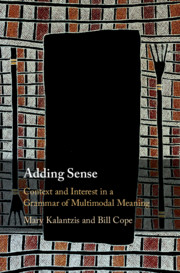Part 1 Context
Published online by Cambridge University Press: 22 April 2020
Summary
Meanings sit in contexts, and contexts become part of meanings. This part of the book focuses on the ways in which context informs meaning.
Meanings are connected to context in the manner of their materialization; some are by likeness (for instance a spoken word that sounds like something, an image that looks like something), by directedness (for instance, a gesture that points to something, or the design of a space that directs wayfinders), or by abstraction (for instance, the arbitrary relation of written word to its referent, or a symbolic object).
Information
- Type
- Chapter
- Information
- Adding SenseContext and Interest in a Grammar of Multimodal Meaning, pp. 21 - 188Publisher: Cambridge University PressPrint publication year: 2020
